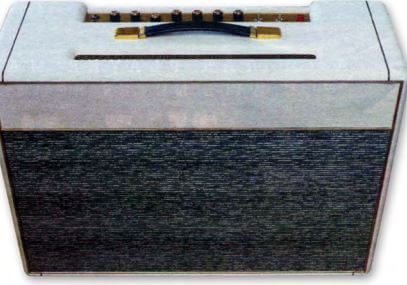
Because there are so many kits and builders in today’s DIY and boutique amp market, you no longer needed to be a super shredder or fretboard wizard to have a “signature” amp. Nope. Today, the only thing between you and the amp of your dreams is a little bit of cash.
For roughly the price of a boutique amp, you can build and customize your own rig – Tolex, grill colors and materials, cabinet plastics and wood types, tube combinations, speaker pairing and sizes, power output – virtually any idea you can think up, and chances are someone can make it a reality. I recently build a 2×12″ 18-watter to my own specifications. Here’s how I did it.
I hemmed and hawed between something more modern-looking and a traditional Tolex-covered cabinet. There are great cab builders who use all kinds of wood. Some variations of the classic tone woods (pine and Baltic birch) are wonderful – walnut, wedge, maple, mahogany, basswood all produce different qualities, and craftsmen are using combinations of them to produce interesting tones. But because I was making my own version of a classic, I decided to go with a traditional cabinet.
The one custom mod I asked Peter to include was to build the cabinet of pine; I’ve always loved the resonance and timbre of pine cabs, and it’s a bit lighter than the birch used in Marshall cabs.
Peter convinced me that while pine would work, I should stay with a birch baffle to retain some of the characteristic bite conveyed by the wood used to build the amp we’re copying.
To further the customization, and give the amp a touch of fun, I decided on white Tolex. Per my request, Peter aged the cab to give it a broken-in appearance.
While I wanted this amp to sound like a Marshall 18-watt, I also wanted more control over its tone. I wasn’t interested in tremolo or reverb as much as saturated overdrive and the ability to obtain overdrive at less than ear-bleed levels. I opted for a Ceriatone DIY kit, which they assembled for a small fee. And since I already had a drawer full of old mustard caps and NOS resistors, I figured I could upgrade some components down the road, if necessary.
Ceriatone had a two-channel Treble/Middle/Bass (T.M.B.) circuit with a Master Volume on the second channel that fit the specifics I was after. I was happy with the quality of workmanship – it had solid solder joints, all around.
I firmly believe transformer iron makes a big difference on an amp’s overall tone and character.
For an 18-watt amp based on a Marshall, you have a power transformer and an output transformer. In the 1940s and ’50s, some power transformers could handle up to eight times the output of an amp! The more muscle, the better the tone.
While an adequate power transformer insures an amp will run at optimum output and efficiency, the output transformer is what really counts when it comes to delivering tight lows and harmonics, and musical sound quality at different volumes.
There are companies making custom transformers and reissuing certain classics, and they all have distinct sounds and characteristics; some are brighter, some more harmonic, some offer crisper note separation, etc. Choosing one is, of course, a matter of taste. Since I was going for that classic dark vintage Marshall sound, I went with Mercury Magnetics, which offers a few choices when it comes to Marshall-style 18-watt output transformers, all based on classic Radiospares transformers from the ’60s and ’70s (which is what Marshall used in the 18-watters). I opted for the handwired ToneClone.
I played with various speakers – Jensen, Celestion Alnicos, old CTS speakers from a Hammond organ, and a few more mismatched combinations. But the thing that really worked was a pair of mid-’60s 20-watt Celestion greenbacks. To my ears, there’s something about an aged magnet in a speaker that makes it less harsh. The 20-watters captured that sweet spot. They’re articulate, punchy, and I really like that they don’t have the boomy low-end of their 25- and 30-watt counterparts. Aside from that, I had an old set that were signed by Alexander Dumble! Not that it makes a difference, tonally, but it’s cool!
Now, some guys wouldn’t pay that much mind to grillecloth, beyond its color. But there are dozens of variations out there… but none of them capture the look – and more importantly, the “feel” – of the vintage “Bluesbreaker” amps.
In the ’60s, Marshall used a rubbery grillecloth material that has never been accurately reproduced. It muffles and colors the amp’s sound in a way that’s unmistakable to old Marshall amps. While I wasn’t opposed to using some funky grillecloth, I really wanted to capture that classic sound. Luckily, I stumbled upon E.C. Collins, who hand-makes a near-duplicate cloth.
While there are plenty of manufacturers making quality tubes these days, I had all the vintage tubes I needed lying around from old projects. The only one I had to source was the rectifier tube, an NOS Mullard EZ81. I had two Valvo EL84s, which I used for the power tubes, and a vintage Mullard, and two vintage Amperex Bugle Boys, which I used for the three ECC83 preamp tubes.
There’s no reason to sacrifice quality to hit a price point. Sure, you might have saved a few bucks if you buy a mass-produced amp, but if you’re after tone and personality, with a little bit of time and planning, you can build the amp of your dreams.
My amp turned out better than I could’ve hoped, and since every component was sourced to my own specs, it truly speaks to me! VG